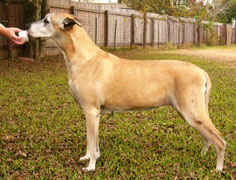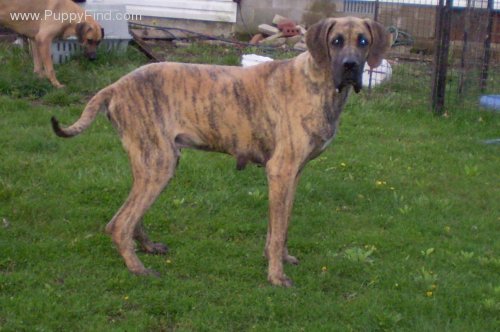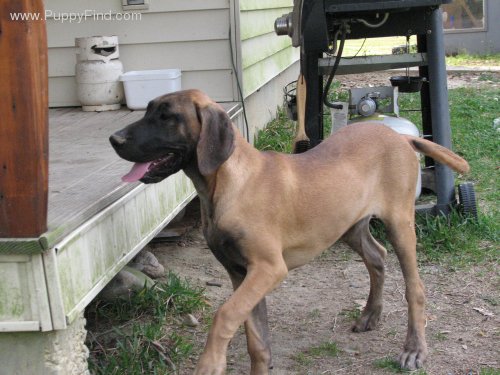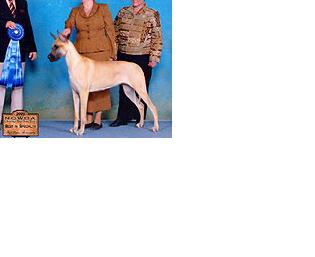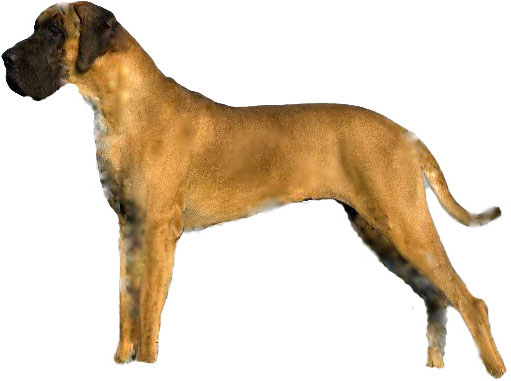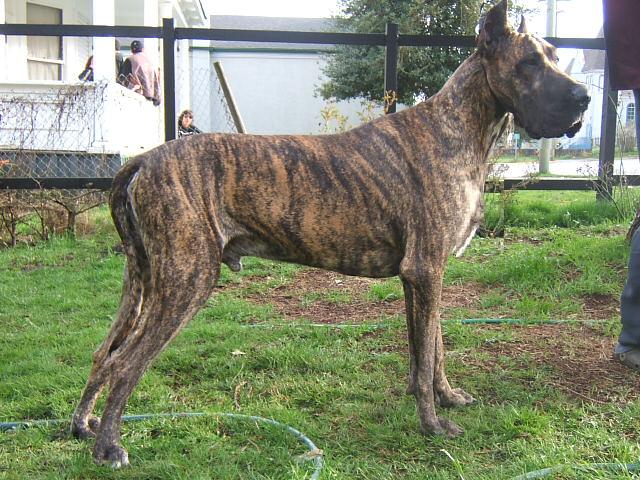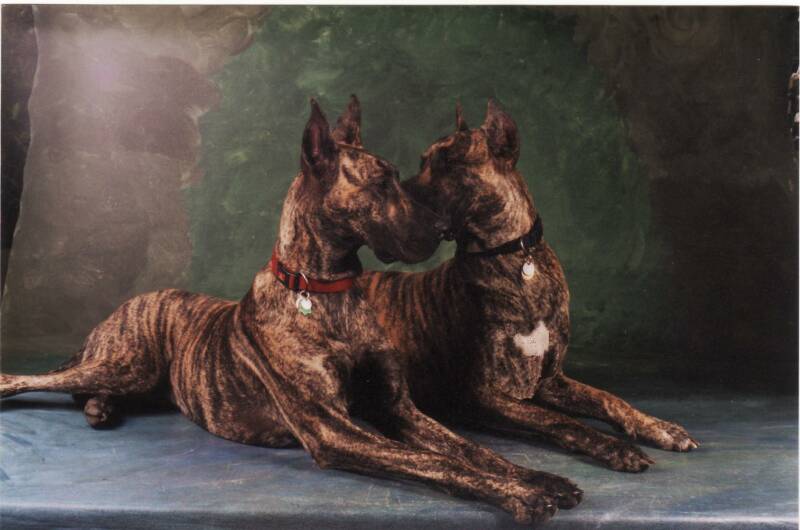Are you purchasing a pup to show and breed? Showing is done as a proof that the dog is worthy of breeding - although it isn't really an absolute proof of true perfect quality. Successful showing and obtaining the title only proves that the Dane is good enough to meet the purebred standard or exceeds it a bit; and as I said, "good" is one thing, "great" is another. The point is, are you planning to breed the Dane or is he just going to be a family pet?
To breed, you need a breeding contract, breeding documents of registration with the official breeders' registration office (AKC or CKC).
A breeding pup carries the risky warranty or guarantee by the breeder that every little unnoticeable and insignificant conformation detail or feature will turn out perfect, and as such, the price of a show/breed pup is about 3 times the price of a pet pup.
It dosn't mean that a showpup is more attractive if the pet pup is a good quality, it just means that certain specifications are met.
To explain, let me quote this write-up from the dogs in Canada magazine by an Ontario reader:
"I paid 4 times the price of a pet pup so I would get the best - I thought, for sure. No one explained to me that they are talking about silly minor insignificant details that may even turn out to be better in a pet pup. I wasn't aware that what I am paying for in reality is the right to breed, in which I have no interest.
The pet pup is still guaranteed against the same health problems .. so what would you get more for a breeding pup - other than the right to breed? well, you get the breeder's guess that the pup will turn out to be better looking (and no breeder can absolutely guarantee that, I was finally told).
Well,. they say if the colour is fawn for example, there shouldn't be even a coin size black spot on the chest, it's a perfect one solid colour! but as far as showing, that isn't true either, we saw show champion studs with a white or back spot on the chest.
I recently found out that a fellow employee purchased a pet pup from the same litter. I couldn't resist comparing the two now, almost adult dogs, his pet VS my show. His turned out to be more of a show dog than mine!
The other fact I wasn't aware of is that one breder may have one good pup per litter, his best, but his his bst may not be as good as the average pup in another breder's litter" Tom Leigh
Well; there is some validity to the statement above. But, most of the time, the breeder's "guess" as the writer called it, is correct.
In our case, so far all our pups turned to be show quality; some are more show than others, but they all were show and what I call it "show plus" pups.
But of course generally when you buy a pet pup, you can't hold the breeder responsible to guarantee that all conformation features will turn out to be as impressive as the breeding or show quality parents. For example, the head may be a little smaller or the top of the head not as flat .. etc. In other words, the Dane - from a good line - will turn out to be a beautiful and quality Dane, but not identical to the exceptional stud .. there may be just that tiny difference that can be only noticed by comparing his picture to that of the show stud. However, in all honesty, in many cases, the breeder couldn't guarantee for sure, with absolute certainty, that the show pup will turn to be identical to the stud or dam any way. Yet, as I repeatedly stated, so far all our pups were either absolutely and perfectly identical to the parents or so close they are still by far great show quality. Remember that our Danes exceed show standard by miles.
Breeders will tell many stories some of which are silly. I recently heard of one case of a dog that when he replaced his puppy teeth (about 28 teeth) with his permanent teeth (about 42 teeth), the pup was 4 teeth short. No big deal, yes, and we even see this happen among us humans, a child from healthy parents with good set of teeth, the child at age 8 or 12 wouldn't develop a molar or would have 2 teeth growing behind each other. It is not an inherited genetic problem, it's one of those cases when genes just don't function perfectly.
As such, do you think any breeder could have predicted that? Do you think it would have made a difference whether it was purchased as a pet or show?
After all, the puppy when he was sold, he had full set of puppy teeth, and, his parents and the line had no teeth shortage!! So it would not have mattered if that person had purchased the pup as a pet or show. And, do you also know that while the average dog has about 42 teeth yet dogs don't chew their food .. they only crush the bones - and for that they use only 6 units .. so, in reality, 35, 40 or 42 teeth means nothing except in the show hall.
A worse case I heard of was to a friend who purchased a male pet pup from an Ontario breeder. The male never dropped his testicles and they were grown inwards. Since it was a pet and was to be castrated anyway, the surgery was just a little different obviously - and had it been a show pup the buyer would have needed to replace the pup. These are rare exceptions.
Many breeders often say, if you buy a pet dog, it's a good purebred dog but it's meant to be a family pet. If he turns to be an exceptional show quality, it's bonus you didn't pay for nor should have demanded it or expected it. Technically they may be right, but really if the breeder's line is a great and healthy line, all his pups, with of course the exception of the rare case we discussed which may never happen, all his pups should turn out to be great dogs - some will be show quality, other will be great show quality.
Again, when you buy a pet pup you buy a mere family pet, a good or very good or even excellent pup but without that piece of paper to guarantee what you didn't pay for. Hence, some people purchase a show pup without intent to breed. They are in a financial position that allows them to pay 3 times the pet pup to obtain the litter's best pup and a written guarantee that the pup will turn out to be of the appearance range and quality of the parents. As I said, with a great line, it is expected that all, most or at least many of the litter pups will have the quality standard of the parents.
So .. to simplify the answer .. many breeders have a good couple of breeding Danes .. good, or very good .. with some good lines in the background, and some great lines .. but also some modest links. They get a wide variety of pup standard in the same litter and may have one obvious (very good) pup in a litter to sell as POTENTIAL show-breeding pup. This is the issue. This is when you may need to purchase and pay extra for a show pup just to get their best pup even though you need a pet pup, but a good pet Dane. See the pictures below to see how it varies from one breeder to another.
In other words, legally, if you don't pay for a show pup, you don't have the right to expect show quality pup.
Again, in our case, we'll be honest and say - unless money is no issue to you, save your money, because "most likely" you'll get that quality any way. But if you want the right to expect an Anubis or Nifi or Cleo - like Dane, you need to pay the extra.
Let me put it this way;
Breeder "x" has two good or very good looking Danes. The line is good enough - or is good, but not secured top quality for several generations. The litter may have a couple of poor pups, a couple of modest pups, a couple of good or very good pups and may have one or two really good and show quality pups.
Breeder "Z" had a couple of secured exceptional quality lines. The litter may have a couple of good pups that may be shown or are close enough, a couple of great pups and several exceptional pups.
With breeder "X" you must purchase a show pup when buying a pet in order to have a good chance to get a quality pet.
With breeder "Z" you only ned to do that if the difference in cost is insignificat to you, keeping in mind that most likely a pet pup will be the quality of the top pup in breeder "X"'s litter. Still, to have the right to expect that quality, and to have a better chance to get it, pay for a show pup when getting you pet pup.
Another way to put it: let us rate quality as 1, 2, 3, 4, 5+ where 1 is a modest to reasonable Dane, 2 is good, 3 is very good (show), 4 is excellent and 5 is exceptional.
Breeder "X" in the paragraph above may have a sire and dam in the 3,4 category, with background Danes in the 2, 3, 4, 5 categories. He'll produced pups that are mostly 2 & 3 and very few 4 and the rare 5.
Breeder "Z" with sire and dame in the 5 category, and a background of 4 & 5, will poduce mostly 4 & 5 and the rare 3.
Now remember that 3 is show quality. When you look at Nifi for exmple, remembr that is in class 5
To illustrate visually, look at these pictures posted by breeders or taken by potential buyer and were emailed to me. And, their owners obviously are displaying their best and meant to boast and brag!!!!
And here is another illustration of high quality Great Danes. Just so that no one would accuse me of self-promotion (despite the fact that I have nothing to sell. I no longer breed) Here are photos sent to me recently by a proud Dane owner, Raechelle Gibbons, of Victoria, BC, and her Dane Tbone:
Now ... male or female?
What else should you look for in a pup?
This is the reason we ask for the puppy application and to a degree also the puppy sales contract. The information you provide will help us select the type of pup, its personality and potential suited to your home and need. Some of the factors to be considered are:
- a family pet or a breeding - showing pup?
- do you have children? young? you need a very laid back or passive pup?
- do you have special needs children?
- do you have other pets? what kind? for example a lady selected a specific female because she showed strong personality signs
and would be able cope with large older dogs she has at home.
- do you have a specific preference as far as features? a great looking head, a large rib cage or a big- chested dog like Anubis? if so, usually
males are are more likely to develop these size feathers, but again, our females as you see are very large with great bone structure.
- specific colour? fawn or brindle and what shade of brindle (all subject to availability of course)
- do you want him as a guard or watch dog? or a calm cuddly pup? or in-between?
Of course chances are, if you select a pet pup, we can only guarantee certain preferences because - for example - if you want a female, light brindle, strong personality .. and we have only one female light brindle or two females but both are not the Alfa type .. well, you can see that only some or one of your specifications you want could be met.
A breeder friend in Ontario told me about a Lady who chose the pup, a female, certain colour and certain characteristics .. she was allowed to examine the litter and pick her own. Later she expressed that she wanted the chest and rib cage feature of the stud - and wanted the big male type structure of the stud's head - but she chose a female - and should have expected the body structure of the elegant dam as opposed to the muscular structure of the stud. If you work with the breeder and tell him your priority preference, he'll help you select the right pup.
Generally, we advise you to leave it to our experience based on the information on your application and your conversation with us. No one so far has been disappointed.
Enjoy your new family member. Your Dane pup will be an incredible source of joy and companionship in your life.






